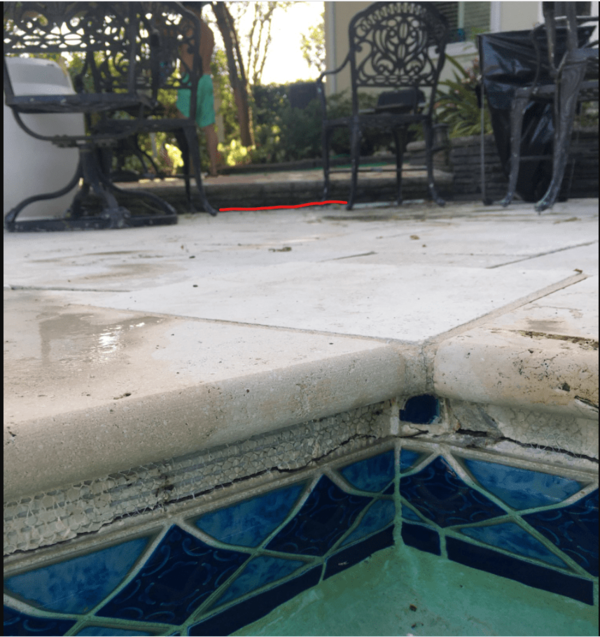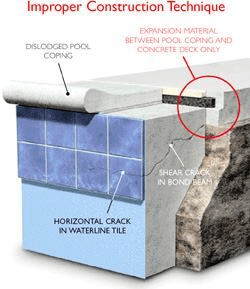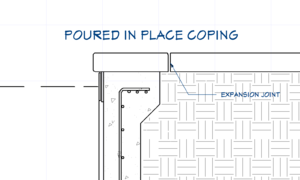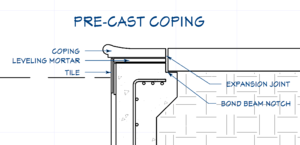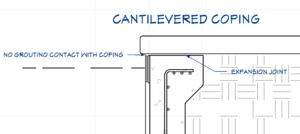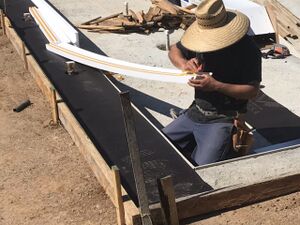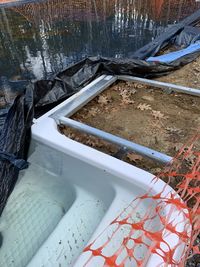| (6 intermediate revisions by the same user not shown) | |||
| Line 1: | Line 1: | ||
=What are Pool Expansion Joints?= | =What are Pool Expansion Joints?= | ||
| − | Expansion joints – | + | Expansion joints – more appropriately called isolation joints – are essential to constructing a structurally sound pool and deck. Concrete (and similar decking options) expand and contract with temperature changes, making an expansion joint necessary to prevent the deck from applying pressure on the pool shell. If not for the expansion joint, pressure from the deck can cause the coping and tile to crack or dislodge. Under extreme cases, the bond beam can develop cracks, leading to failure of the beam and allowing the entry of water and root systems from nearby landscape, causing further damage. |
[[File:Pool Expansion Joint Bond Beam Cracks.png|600px|thumb]] | [[File:Pool Expansion Joint Bond Beam Cracks.png|600px|thumb]] | ||
| − | The type of expansion joint varies | + | The type of expansion joint varies depending on the type/style of coping used, but it should generally be at least ½” thick of unobstructed compressible space for vertical joints and a “decoupling” joint for horizontal joints. |
| − | The expansion joint needs to be the entire thickness of the deck. If the deck goes below the bond beam then you need to dig down until you find the bottom of the deck and start the expansion joint there.<ref>https://www.troublefreepool.com/threads/pool-currently-demod-long-crack-under-coping.193401/post-1709026</ref> | + | The expansion joint needs to be the entire thickness of the deck. If the deck goes below the bond beam, then you need to dig down until you find the bottom of the deck and start the expansion joint there.<ref>https://www.troublefreepool.com/threads/pool-currently-demod-long-crack-under-coping.193401/post-1709026</ref> |
| + | |||
| + | [https://www.aquamagazine.com/builder/article/15121913/mind-the-gaps-perfecting-control-and-expansion-joints Aqua Magazine] says I like to see a gap that's ½-inch wide between the deck and the coping. The gap should extend downward through the entire depth of the slab, usually about 4 inches. | ||
[https://www.troublefreepool.com/threads/tiles-popping-off.237741/#post-2080958 This thread] shows what can happen without a proper expansion joint. | [https://www.troublefreepool.com/threads/tiles-popping-off.237741/#post-2080958 This thread] shows what can happen without a proper expansion joint. | ||
| Line 14: | Line 16: | ||
[https://www.troublefreepool.com/threads/bond-beam-repair.199409/post-1763181 Bond Beam Repair] shows how a cracked bond beam needs to be rebuilt. | [https://www.troublefreepool.com/threads/bond-beam-repair.199409/post-1763181 Bond Beam Repair] shows how a cracked bond beam needs to be rebuilt. | ||
| − | Also see [ | + | Also, see [https://www.pooleng.com/minimizing-swimming-pool-structural-problems-due-to-concrete-deck-construction/ Pool Engineering Inc. - Minimizing Swimming Pool Structural Problems Due to Concrete Deck Construction]. |
| + | |||
| + | [https://www.troublefreepool.com/threads/how-to-replace-your-pools-mastic-complete-guide-by-a-pool-newbie.209977/#post-2602116 How to Replace Your Pools Mastic - Complete Guide by a Pool Newbie] is a good explanation of how to maintain your expansion joint. | ||
=Three Most Common Types of Coping= | =Three Most Common Types of Coping= | ||
| − | The three most common types of coping are poured in place, precast and cantilevered decking. | + | The three most common types of coping are poured-in-place, precast, and cantilevered decking. |
Vertical expansion joints in Poured in Place and Precast coping are typically filled with Backer Rod foam rope and then covered with flexible mastic like [https://www.deckoseal.com/04/11/deck-o-seal-polysulfide-based-joint-sealant/ Deck-O-Seal] or [https://usa.sika.com/sarnafil/en/pvc-roofing/sealants/sikaflex-1a.html Sikaflex®-1A]. | Vertical expansion joints in Poured in Place and Precast coping are typically filled with Backer Rod foam rope and then covered with flexible mastic like [https://www.deckoseal.com/04/11/deck-o-seal-polysulfide-based-joint-sealant/ Deck-O-Seal] or [https://usa.sika.com/sarnafil/en/pvc-roofing/sealants/sikaflex-1a.html Sikaflex®-1A]. | ||
| − | For joints over 1/4 inch, Backer Rod, | + | For joints over 1/4 inch, Backer Rod, a foam rope, should be placed in the expansion joint before applying the sealant. The Backer Rod should be pressed into the joint, allowing a sealant depth of between 1/8 inch and 1/2 inch. Polyurethane sealants work best when they are bonded only to the inside edges of the crack or joint. |
| − | Horizontal expansion joints in cantilevered coping | + | Horizontal expansion joints in cantilevered coping are typically left open. |
==Poured in Place== | ==Poured in Place== | ||
[[File:Poured in Place Coping.png|300px|thumb|Poured in Place Coping]] | [[File:Poured in Place Coping.png|300px|thumb|Poured in Place Coping]] | ||
| − | Forms are placed using the shell for support and concrete is poured directly on top of the bond beam. The coping is usually as wide (or wider) than the bond beam (roughly 14”-16”). Control joints should be saw cut or tooled at 24” intervals but the closer the joints are, the less chance of shrinkage cracks developing. Tile is usually placed after the coping is poured to not interfere with the forms but can be installed prior if Stegmeier type forms are used. | + | Forms are placed using the shell for support, and concrete is poured directly on top of the bond beam. The coping is usually as wide (or wider) than the bond beam (roughly 14”-16”). Control joints should be saw cut or tooled at 24” intervals, but the closer the joints are, the less chance of shrinkage cracks developing. Tile is usually placed after the coping is poured to not interfere with the forms but can be installed prior if Stegmeier type forms are used. |
| − | The expansion joint is placed between the coping and deck and | + | The expansion joint is placed between the coping and deck and extends vertically the entire thickness of the deck and pool shell (if exposed). |
==Precast Coping== | ==Precast Coping== | ||
[[File:Pre-Cast Coping.png|300px|thumb|Pre-Cast Coping]] | [[File:Pre-Cast Coping.png|300px|thumb|Pre-Cast Coping]] | ||
| − | Coping is pre-made separate from the pool and can be a safety type coping (pictured), stone, pavers, etc. Tile is typically installed | + | Coping is pre-made separate from the pool and can be a safety-type coping (pictured), stone, pavers, etc. Tile is typically installed before the placement of the coping to establish a level waterline and aid in setting the coping pieces, though it can just as easily be installed afterward. A mortar bed is placed on top of the bond beam to level and secure the coping in place. |
| − | In some cases, the precast coping will not be as wide as the bond beam and a notch on the backside will need to be made either during the placement of the gunite/shotcrete or saw cut after it has cured. | + | In some cases, the precast coping will not be as wide as the bond beam, and a notch on the backside will need to be made either during the placement of the gunite/shotcrete or saw cut after it has cured. |
| − | The expansion joint should be placed between the coping and deck | + | The expansion joint should be placed between the coping and the deck, extending down far enough to isolate the entire pool structure from the entire depth of the deck. |
==Cantilevered Deck== | ==Cantilevered Deck== | ||
[[File:Cantilevered Coping.png|300px|thumb|Cantilevered Coping]] | [[File:Cantilevered Coping.png|300px|thumb|Cantilevered Coping]] | ||
| − | The decking is also used as the coping which is placed in one continuous pour to create a seamless looking deck. Prior to pouring the deck, | + | The decking is also used as the coping, which is placed in one continuous pour to create a seamless-looking deck. Prior to pouring the deck, the grade should be brought up to become level with the top of the bond beam and very well compacted. |
| + | |||
| + | A “decoupling” expansion joint should extend across the width of the top of the bond beam to allow the deck to move independently of the pool shell. This joint can be created with a four mil plastic sheet or two layers of roofing felt underlayment. | ||
| − | + | [[File:Cantilevered Expansion Joint Felt Slip Joint.jpg|thumb]] | |
| − | + | The waterline tile must be installed after the deck is placed so there is no chance of the deck expanding and popping off the tile (see tile placement in the diagram). The tile can be grouted as usual, but the top joint between the deck and the tile should be filled with a flexible sealant that is not silicone-based. | |
=Steel Wall Liner Pool Coping= | =Steel Wall Liner Pool Coping= | ||
[[File:Steel wall liner pool coping.jpg|200px|thumb]] | [[File:Steel wall liner pool coping.jpg|200px|thumb]] | ||
| − | If the liner is in you cannot use forms like Stegmeier to pour cantilever concrete.<ref>https://www.troublefreepool.com/threads/new-inground-pool-decking-and-coping.200676/post-1772571</ref> The form needs the liner track empty to attach them so that can not be done once the liner is installed. The white strip on the edge | + | If the liner is in, you cannot use forms like Stegmeier to pour cantilever concrete.<ref>https://www.troublefreepool.com/threads/new-inground-pool-decking-and-coping.200676/post-1772571</ref> The form needs the liner track empty to attach them so that can not be done once the liner is installed. The white strip on the edge holds the liner in a cantilever coping setup. You are limited to precast coping after the liner is installed. |
| − | When you install stairs on a steel wall kit and | + | When you install stairs on a steel wall kit, and know ahead of time you will use cantilevered coping, you want the stairs set to the height of the top of the track strip, usually 1/4 to 3/8" higher than normal. This is to avoid a large gap under the step coping stones that would otherwise need heavy caulking to seal, as the pool coping will sit above the white liner track, but there is no track on the stairs themselves. |
| − | The stairs in the picture to the right are set flush with wall panels and | + | The stairs in the picture to the right are set flush with wall panels, and there is a heavy caulk joint for this pool. |
| − | Stone should always be used for all the backfill. Dirt will always settle and you can not compact dirt well against the walls without damaging | + | Stone should always be used for all the backfill. Dirt will always settle, and you can not compact dirt well against the walls without damaging them. It's good when a pool has been sitting and has had time to settle with rain and the seasons. |
| − | It is best to pick the coping first. Then you know what width you need to form up, | + | It is best to pick the coping first. Then, you know what width you need to form up, which is a few inches thick and as high as the steel wall, for the concrete pour. You usually have a 1" overhang, so the form will be 1 to 1.5 inches narrower than the coping so it doesn't stick out behind them. |
| − | You want the coping independent | + | You want the coping to be independent of the deck concrete or pavers behind it. Use a strip of cement board on top of a steel panel or wire mesh to provide adhesion to the front of the coping that sits on the steel wall. The base under the form should be well compacted stone base material. |
| − | You should | + | You should add small rebar pieces through one of the upper bolt holes in the steel panels to reinforce that area. The reinforcement is needed because the concrete is thinner where the panels meet due to the shape of the panel seams. |
| − | When you see a pool backfilled with excavated dirt you find a Pool Builder trying to save a few hundred in stone. Down the road if it settles and cracks the deck it | + | When you see a pool backfilled with excavated dirt, you find a Pool Builder trying to save a few hundred in stone. Down the road, if it settles and cracks the deck, it will cost thousands to fix and be a real pain. It is better to do whatever you can to avoid that. It's not worth the skimp in the big picture. |
Latest revision as of 18:43, 23 November 2024
What are Pool Expansion Joints?
Expansion joints – more appropriately called isolation joints – are essential to constructing a structurally sound pool and deck. Concrete (and similar decking options) expand and contract with temperature changes, making an expansion joint necessary to prevent the deck from applying pressure on the pool shell. If not for the expansion joint, pressure from the deck can cause the coping and tile to crack or dislodge. Under extreme cases, the bond beam can develop cracks, leading to failure of the beam and allowing the entry of water and root systems from nearby landscape, causing further damage.
The type of expansion joint varies depending on the type/style of coping used, but it should generally be at least ½” thick of unobstructed compressible space for vertical joints and a “decoupling” joint for horizontal joints.
The expansion joint needs to be the entire thickness of the deck. If the deck goes below the bond beam, then you need to dig down until you find the bottom of the deck and start the expansion joint there.[1]
Aqua Magazine says I like to see a gap that's ½-inch wide between the deck and the coping. The gap should extend downward through the entire depth of the slab, usually about 4 inches.
This thread shows what can happen without a proper expansion joint.
Bond Beam Repair shows how a cracked bond beam needs to be rebuilt.
How to Replace Your Pools Mastic - Complete Guide by a Pool Newbie is a good explanation of how to maintain your expansion joint.
Three Most Common Types of Coping
The three most common types of coping are poured-in-place, precast, and cantilevered decking.
Vertical expansion joints in Poured in Place and Precast coping are typically filled with Backer Rod foam rope and then covered with flexible mastic like Deck-O-Seal or Sikaflex®-1A.
For joints over 1/4 inch, Backer Rod, a foam rope, should be placed in the expansion joint before applying the sealant. The Backer Rod should be pressed into the joint, allowing a sealant depth of between 1/8 inch and 1/2 inch. Polyurethane sealants work best when they are bonded only to the inside edges of the crack or joint.
Horizontal expansion joints in cantilevered coping are typically left open.
Poured in Place
Forms are placed using the shell for support, and concrete is poured directly on top of the bond beam. The coping is usually as wide (or wider) than the bond beam (roughly 14”-16”). Control joints should be saw cut or tooled at 24” intervals, but the closer the joints are, the less chance of shrinkage cracks developing. Tile is usually placed after the coping is poured to not interfere with the forms but can be installed prior if Stegmeier type forms are used. The expansion joint is placed between the coping and deck and extends vertically the entire thickness of the deck and pool shell (if exposed).
Precast Coping
Coping is pre-made separate from the pool and can be a safety-type coping (pictured), stone, pavers, etc. Tile is typically installed before the placement of the coping to establish a level waterline and aid in setting the coping pieces, though it can just as easily be installed afterward. A mortar bed is placed on top of the bond beam to level and secure the coping in place.
In some cases, the precast coping will not be as wide as the bond beam, and a notch on the backside will need to be made either during the placement of the gunite/shotcrete or saw cut after it has cured. The expansion joint should be placed between the coping and the deck, extending down far enough to isolate the entire pool structure from the entire depth of the deck.
Cantilevered Deck
The decking is also used as the coping, which is placed in one continuous pour to create a seamless-looking deck. Prior to pouring the deck, the grade should be brought up to become level with the top of the bond beam and very well compacted.
A “decoupling” expansion joint should extend across the width of the top of the bond beam to allow the deck to move independently of the pool shell. This joint can be created with a four mil plastic sheet or two layers of roofing felt underlayment.
The waterline tile must be installed after the deck is placed so there is no chance of the deck expanding and popping off the tile (see tile placement in the diagram). The tile can be grouted as usual, but the top joint between the deck and the tile should be filled with a flexible sealant that is not silicone-based.
Steel Wall Liner Pool Coping
If the liner is in, you cannot use forms like Stegmeier to pour cantilever concrete.[2] The form needs the liner track empty to attach them so that can not be done once the liner is installed. The white strip on the edge holds the liner in a cantilever coping setup. You are limited to precast coping after the liner is installed.
When you install stairs on a steel wall kit, and know ahead of time you will use cantilevered coping, you want the stairs set to the height of the top of the track strip, usually 1/4 to 3/8" higher than normal. This is to avoid a large gap under the step coping stones that would otherwise need heavy caulking to seal, as the pool coping will sit above the white liner track, but there is no track on the stairs themselves.
The stairs in the picture to the right are set flush with wall panels, and there is a heavy caulk joint for this pool.
Stone should always be used for all the backfill. Dirt will always settle, and you can not compact dirt well against the walls without damaging them. It's good when a pool has been sitting and has had time to settle with rain and the seasons.
It is best to pick the coping first. Then, you know what width you need to form up, which is a few inches thick and as high as the steel wall, for the concrete pour. You usually have a 1" overhang, so the form will be 1 to 1.5 inches narrower than the coping so it doesn't stick out behind them.
You want the coping to be independent of the deck concrete or pavers behind it. Use a strip of cement board on top of a steel panel or wire mesh to provide adhesion to the front of the coping that sits on the steel wall. The base under the form should be well compacted stone base material.
You should add small rebar pieces through one of the upper bolt holes in the steel panels to reinforce that area. The reinforcement is needed because the concrete is thinner where the panels meet due to the shape of the panel seams.
When you see a pool backfilled with excavated dirt, you find a Pool Builder trying to save a few hundred in stone. Down the road, if it settles and cracks the deck, it will cost thousands to fix and be a real pain. It is better to do whatever you can to avoid that. It's not worth the skimp in the big picture.


